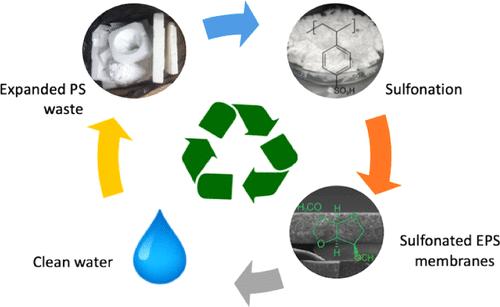以二甲基异山梨酯为绿色溶剂处理膨胀聚苯乙烯废水的可持续膜
IF 7.3
1区 化学
Q1 CHEMISTRY, MULTIDISCIPLINARY
引用次数: 0
摘要
本研究报告了通过3%和5% (EPS-3和EPS-5)的直接磺化,将膨胀聚苯乙烯(EPS)废物升级为用于水处理的功能膜。通过FTIR、酸碱滴定和差示扫描量热法证实了−SO3H基团的成功掺入。二甲基异山梨酯因其平衡的粘度、聚合物亲和性和成本效益而被确定为膜制造的最佳溶剂。膜呈不对称多孔形态,孔径和渗透通量随磺化程度的增加而增大,总孔隙度保持在74%左右。水接触角从纯EPS的90.7°下降到EPS-3的84.9°和EPS-5的71.2°,反映出更高的润湿性和吸水性(从2.9%上升到11.6%)。在9 bar时,ps -5的渗透通量从1.01 L·m-2·h-1增加到4.83 L·m-2·h-1,活性黑5的截留率从94提高到97%。力学性能保持不变,杨氏模量在146.5 ~ 127.2 MPa之间,抗拉强度稳定。总的来说,本研究提出了一种可持续和经济的方法,将不可生物降解的EPS废物转化为有价值的膜,用于压力驱动水处理,同时解决聚合物废物管理和水污染问题。本文章由计算机程序翻译,如有差异,请以英文原文为准。

Sustainable Membranes for Water Treatment from Expanded Polystyrene Waste Using Dimethyl Isosorbide as a Green Solvent
This study reports the upcycling of expanded polystyrene (EPS) waste into functional membranes for water treatment through direct sulfonation at 3% and 5% (EPS-3 and EPS-5). Successful incorporation of −SO3H groups was confirmed by FTIR, acid–base titration, and differential scanning calorimetry. Dimethyl isosorbide was identified as the optimal solvent for membrane fabrication due to its balanced viscosity, polymer affinity, and cost-efficiency. The membranes exhibited an asymmetric porous morphology, with the pore size and permeate flux increasing with the sulfonation degree, while total porosity remained close to 74%. Water contact angle decreased from 90.7° for pure EPS to 84.9° for EPS-3 and 71.2° for EPS-5, reflecting higher wettability and water uptake (from 2.9% to 11.6%). At 9 bar, the permeate flux increased from 1.01 to 4.83 L·m–2·h–1 for EPS-5, and Reactive Black 5 rejection increased from 94 to 97% at 5 bar. Mechanical properties were preserved, with Young’s modulus ranging from 146.5 to 127.2 MPa and stable tensile strength. Overall, this study presents a sustainable and cost-effective approach to convert nonbiodegradable EPS waste into valuable membranes for pressure-driven water treatment, simultaneously addressing polymer waste management and water pollution.
求助全文
通过发布文献求助,成功后即可免费获取论文全文。
去求助
来源期刊

ACS Sustainable Chemistry & Engineering
CHEMISTRY, MULTIDISCIPLINARY-ENGINEERING, CHEMICAL
CiteScore
13.80
自引率
4.80%
发文量
1470
审稿时长
1.7 months
期刊介绍:
ACS Sustainable Chemistry & Engineering is a prestigious weekly peer-reviewed scientific journal published by the American Chemical Society. Dedicated to advancing the principles of green chemistry and green engineering, it covers a wide array of research topics including green chemistry, green engineering, biomass, alternative energy, and life cycle assessment.
The journal welcomes submissions in various formats, including Letters, Articles, Features, and Perspectives (Reviews), that address the challenges of sustainability in the chemical enterprise and contribute to the advancement of sustainable practices. Join us in shaping the future of sustainable chemistry and engineering.
 求助内容:
求助内容: 应助结果提醒方式:
应助结果提醒方式:


